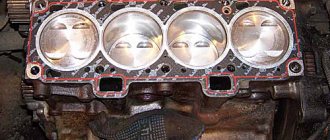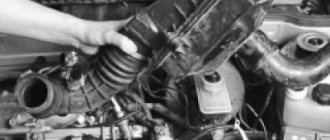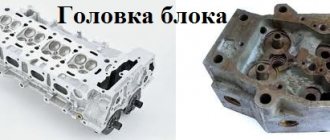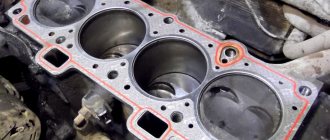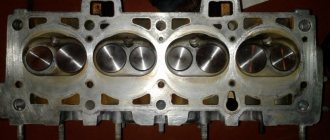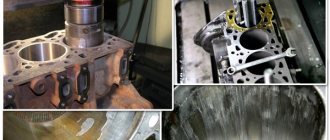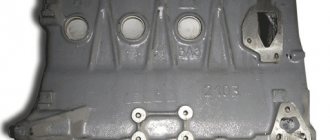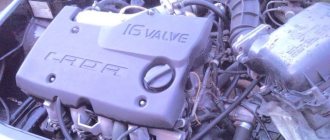VAZ engine block height
The 21083 cylinder block
was originally created for a carburetor engine and did not provide for mounting points for elements found on injection engines (knock sensor, ignition module, etc.). Later, the casting of the model was unified and became the same for models 21083, 2110 and 2112. All these models are distinguished by the fact that they have the same height and are used on engines with a volume of 1500 cm3. Therefore, on the body of all these blocks, there is an inscription in the casting - “21083”. Now a product with the item number – 21083-100201100 – is being shipped from the factory as a spare part.
On the body of the “83rd” tides appeared, which are present on all models of the “front-wheel drive” engine family. But threaded holes are present only on the bosses that are used to install the equipment. On the unified cylinder block of the VAZ 21083, below the installation location of the oil filter, a boss and holes appeared for installing an oil level sensor. For fastening the block head on the upper plane there are ten holes M12x1.25. Cylinder block 21083 is painted blue.
After the unification of the “083rd”, the VAZ 2110 cylinder block
has lost its distinctive features associated with the presence of additional tides on the body. Now it looks no different from “083”. In BC 2110, to install the right engine mount bracket and the generator mounting plate, three threaded holes are used in the upper part and three holes in the lower part of the casting for the generator bracket. The product is installed on “injection” engines, so there is a place on the cylinder block for installing a knock sensor.
As in the “083”, the installation of an oil level sensor is provided. Cylinder block 2110 can be used to assemble a VAZ 21083 engine. Block 2110 is painted gray.
In collaboration with the Federal Mogul company, a new VAZ 21126 engine was created. The main task facing the specialists was to increase the service life of the engine and ensure compliance with increased environmental standards for exhaust toxicity. The VAZ 11193 cylinder block was taken as the basis. The modified product received a new designation - 21126. Cylinder block 21126
distinguished by the quality of surface treatment of the cylinder, made using Federal Mogul technology. Using this technology, the surface of the cylinder is subjected to flat-top honing. This operation ensures that a network of microgrooves of a certain profile is obtained on the surface of the cylinder. The micro-profile allows the lubricant to be retained on the surface of the cylinder, significantly reducing friction losses.
Cylinder block 11194
, was specially designed for the 1.4 liter engine. For this purpose, the cylinder diameter was reduced to 76.5 mm. Externally, structurally and in terms of the presence of places for mounting equipment, the block does not differ from model 11193 or model 21126. However, the cylinder block 11194 has a hidden difference; this feature distinguishes it from other “front-wheel drive” blocks.
Reducing the diameter of the cylinders made it possible to create cooling jacket ducts between adjacent cylinders. This significantly improved heat dissipation and increased structural rigidity. The surface treatment of the cylinders is carried out using Federal Mogul technology, similar to the processing performed on the “21126”. On the surface of the case there is an inscription - “11194”. The VAZ 11194 cylinder block is painted blue.
Source
Engine VAZ 21083-100026053. Characteristics of the VAZ 21083 engine.
The engine is four-stroke, carburetor, in-line, with an overhead camshaft. The engine cooling system is liquid, closed type, with forced circulation of liquid. The engine has a combined lubrication system: pressure and splash.
Cylinders: 4 Cylinder displacement, l: 1,5 Compression ratio: 9,9 Rated engine power at a crankshaft speed of 5600 rpm: 49.8 kW.-(69 hp) Cylinder diameter, mm: 82 Piston stroke, mm: 71 Number of valves: 8 Minimum crankshaft speed, rpm: 750-800 Maximum torque at 3400 rpm, N*m: 106,4 Cylinder operating order: 1-3-4-2 Octane number of gasoline: 92-95 Fuel supply system: carburetor Spark plug: A17DVRM, FE65CPR Weight, kg: 127,3 Designed for installation on VAZ models: 2108, 21083, 2109, 21093, 21099, 2113, 2114, 2115 and their modifications.
The VAZ 21083 engine, like its predecessor, the VAZ 2108 engine, was specially designed for transverse placement in the engine compartment of a car.
The cylinder block 21083 is made with a cylinder center size of 89 mm. The overall dimensions of block 21083 correspond to the dimensions of block 2108. The height from the axis of the crankshaft to the upper surface of the block is 194.8 mm. They differ in the diameter of the cylinders. On block 21083, the cylinder diameter was increased to 82.00mm. The class of the cylinder is indicated in Latin letters and marked on the bottom surface of the block in accordance with the dimensions of the cylinder diameter. The design of the unit does not provide for the possibility of using a drive shaft for auxiliary units.
The engine is equipped with a crankshaft model 2108-1005016. The radius of the crank shaft is 35.5mm. (piston stroke – 71mm.). The diameter of the generating circle of the counterweights is 131 mm, the width of the counterweight cheek is 102 mm, the diameter of the connecting rod journal is 47.83 mm. There is no marking on the shaft.
A new piston is used. Piston - 21083-1004015. A new piston design was used, developed with the help of the German companies Porsche and Kolbenschmidt. Unlike pistons for 2106 and 2103, they are not coated with a layer of tin. On “German” pistons, a special microprofile is used on the side surfaces of the piston. This micro-profile allows you to retain lubricant under any engine operating conditions. Repair dimensions of pistons - 82.4 mm; 82.8mm.
The piston pin is used mod. 21213. When installed, it is pressed into the upper head of the connecting rod, but ensures free rotation in the piston bosses. The piston pin has a length of 67mm, diameter of 22mm.
New rings with a diameter of 82 mm are installed on new pistons. The height of the rings remained the same: the first compression ring is 1.5 mm; second compression – 2mm; oil scraper -3.95mm. Oil scraper ring – chrome plated. The kit designation for normal size is 21083-1000100-10. It is possible to install steel piston rings 21083-1004029.
Connecting rod - 2108-1004045. The length of the connecting rod is 121mm. Connecting rods 2108 (2110) are heavier than connecting rods 2101 (21213). The upper head of the connecting rod is made more massive. The tides on the upper head are made on both sides.
Flywheel 2108-1005115. The diameter of the surface for the clutch is 196 mm. The width of the flywheel crown is 20.9 mm.
The engine received a new cylinder head 21083. The diameters of the intake valves were changed (from 35mm to 37mm). Optimization of the fuel combustion process made it possible to increase the compression ratio to 9.9.
Camshaft - 2108-1006015. It should be distinguished from camshaft 21081. On the shaft 21081-1006015 there is a raw cylindrical belt between the third and fourth cams. At the rear of the camshaft there is an eccentric that drives the fuel pump.
The camshaft is driven by a toothed belt 2108-1006040-10. The timing belt has 111 teeth and is 19mm wide. The teeth on the belt have an involute profile. The belt is tensioned by a special tension roller 2108-1006120. A toothed pulley 2108-1006020 is installed on the camshaft, and a pulley 2108-1005030 is installed on the crankshaft. The pulley teeth have a profile that matches the profile of the timing belt.
The VAZ 21083 engine is equipped with a new type of oil pump, mod.2108, with internal gears. It is installed in the front part of the cylinder block. A design feature of the oil pump is that it is driven directly from the crankshaft.
On the fuel pump mod.2108, the inlet and outlet pipes are located on the same line, this is its main difference from the fuel pump 2101. The new carburetor, 21083-110701000, ensures more economical operation of the engine.
The VAZ 2108 engine uses an electronic non-contact ignition system. The system includes: ignition distributor sensor type 40.3706 or 40 3706 - 01, switch model 3620 3734 or 763734, ignition coils 3122 3705, spark plugs, ignition switch and high voltage wires.
The cooling system uses a new design water pump with index 2108.
Generator 372.3701 (current 55A).
VAZ engine block height
The 21083 cylinder block was originally designed for the parameters of a carburetor engine.
Consequently, it did not provide for the presence of areas for fastening elements by analogy with injection engines, including the ignition module, knock sensor, etc. Subsequently, the casting of the model is unified, as a result of which it becomes uniform for blocks 21083, 2110 and 2112. They all have the same height and can be used on engines with a volume of 1500 cm3. Therefore, the body of these blocks is cast. Today, a product with item number 21083-100201100 is shipped from factories as a spare part. The body of the “83rd” has tides, the same as on all other engine blocks of front-wheel drive VAZ cars. However, there are threaded holes here only on the bosses involved in installing the equipment. The unified cylinder block for the VAZ 21083 also has a boss for installing an oil level sensor, which is located under the oil filter. In order to secure the block head on the upper plane there are 10 holes in the M12x1.25 format. The color of the cylinder block 21083 is blue.
The unification of “083” led to the loss of the VAZ 2110 cylinder block of its characteristic features associated with additional tides on the body. Outwardly, today it is indistinguishable from “083”. The BC 2110 also uses three upper threaded holes and three lower holes of the casting part for installing the right engine support brackets and mounting the generator mounting plate. Since this product is mounted on “injection” engines, the cylinder block has space for installing a knock sensor.
By analogy with “083”, it is assumed that an oil level sensor will be installed here. In addition, the 2110 cylinder block is often used to assemble VAZ 21083 engines. The color of the 2110 block is gray.
Today AVTOVAZ does not produce cylinder block 21114; the alternative model is BC 11183. These two models are virtually identical. The color of the cylinder block 11183 is grey.
The 21126 cylinder block has the highest quality surface treatment, performed in accordance with Federal Mogul technology. During this process, the cylinder is subjected to flat-top honing, which makes it possible to obtain a network of microgrooves of a special profile on its surface. It is this that reliably holds the lubricant on the surface of the product, while reducing energy loss due to friction. Thus, the honing technology that is used at AVTOVAZ when processing the surface of the cylinders of the VAZ 21126 block differs from previous models.
Federal Mogul has developed the main technological parameters for surface honing. This includes the angle of inclination, its profile, and the frequency of application of microgrooves. When performing the operation, high-quality equipment from Federal Mogul is used. High manufacturing precision makes it possible to determine three groups of cylinder sizes: A, B, C. The reliability of the engine is increased not only due to the new manufacturing technology of the cylinder block, but also due to the new piston kit, which consists of a piston + pin + rings + connecting rod. The color of the cylinder block 21126 is blue.
Cylinder block 11194 is a specialized development for engines with a volume of 1.4 liters. In this regard, the cylinder diameter was reduced to 76.5 mm. However, in terms of its design and the presence of places for mounting equipment, block 11194 is practically indistinguishable from models 11193 and 21126. However, cooling jacket ducts are made between adjacent cylinders, due to a decrease in their diameter. This made it possible to improve heat dissipation and increase structural rigidity. A similar treatment of the surface of the cylinders in accordance with Federal Mogul technology is carried out on model 21126. The color of the VAZ 11194 cylinder block is blue.
Source
Engine 21213 (1.7l 79hp)
ENGINE VAZ 21213-1000260.
CHARACTERISTICS OF THE VAZ 21213 ENGINE.
The engine is carburetor, the camshaft is located on top.
| Number of cylinders: | 4 |
| Cylinder displacement: | 1.69 l |
| Compression ratio: | 9,3 |
| Power at a crankshaft speed of 5200 rpm: | 58 kW /7 8.9 hp |
| Cylinder diameter: | 82mm |
| Piston stroke: | 80mm |
| Number of valves: | 8 |
| Minimum crankshaft rotation speed rpm: | 750 — 800 |
| Maximum torque at 3400 rpm: | 127N*m |
| Cylinder operating order: | 1-3-4-2 |
| Octane number of gasoline: | AI-92 |
| Fuel supply system: | carburetor |
| Spark plug: | A17DVR, BP6ES (NGK) |
| Weight: | 117 kg |
Engine Features.
The VAZ-21213 engine is installed on Niva-2121, 21213, 21214, 2131 (long Niva) cars; VAZ -2120 Nadezhda
Designed specifically for Niva-21213.
- Engine cylinder block 21213-1002011 with a center-to-center distance of 95 mm and a height of 214.58-0.1 mm (distance from the axis of rotation of the crankshaft to the upper surface of the block). The cylinder diameter is 82mm. (repair sizes of cylinders - 82.4 and 82.8) Cylinders come in five classes A, B, C, D. The size of each class differs from the previous one by 0.01 mm. The cylinder block markings are located on the bottom surface.
- Crankshaft 21213-1005015 corresponds to the crankshaft of the VAZ-2103. The shaft has additional counterweights that reduce vibration. There are two oil supply holes on each connecting rod journal. The diameters of the shaft journals are increased by 0.02 mm. When using standard bearings, this reduction in clearances optimizes the thickness of the oil layer between the shaft journal and the bearing surface. Crankshaft 21213 is recommended for installation instead of shaft 2103.
- New piston group . Piston 21213 has a special oval hole on the bottom. Hole for piston pin D=22mm. The hole in the piston for the pin is offset by 1.2 mm from the piston axis. Piston pin length 67mm Piston weight - 347g. Connecting rod 21213-1004045 . Connecting rod length 136 mm. Hole sizes: for the connecting rod journal - 47.8 mm; under the piston pin – 22mm.
- Cylinder head 21213-1002011 (1.7 l.) Cylinder head height 21213 - 111.0 mm (1.8 mm lower than head 21011) Combustion chamber size - 81x52 mm, volume 30 cm3.
- Camshaft 21213-1006010 . The shape of the cams has been changed to increase the intake valve stroke.
- Valves and valve mechanism from the VAZ-2101 engine.
- Timing chain 2103. Extended tensioner shoe.
- Carburetor 21073 SOLEX.
- BSZ ignition system (non-contact ignition system): Ignition distributor (distributor) 3810.3706 (21213-3706010) or equivalent 2107.3706.010-21 . Switch - 3620.3734 SOATE or 133.3774-01 (2108) Ignition coil - 27.3705 (2108)
Help on VAZ classic engine sizes
author 1111 Thu Jan 14, 2010 9:42 pm
Information on the sizes of VAZ classic engines:
We have an engine 2101 or 21011 with volumes of 1.2 and 1.3 respectively, what can we get? from 2101 blocks we can get volumes of 1.5 and 1.6 liters, from 21011 blocks 1.6 and 1.7. What is needed for this? 1. Crankshaft 2103 (if you hear a crankshaft 2106 or 2121 somewhere, then keep in mind that the engine 2106 has a KV 2103, the Niva 2121(!) had a 2106 engine), or 21213 (it will be better) 2. Connecting rods Shortened, if we increase the volume connecting rods, then you can leave the original pistons, it all depends on the service life of the engine, if we sharpen then take new pistons))) 3. Pistons (If we install original or 213 connecting rods)
the rest is according to Murzilka.
Large R/S effect:
PRO: Allows the piston to remain at TDC longer, which ensures better combustion of the fuel mixture, i.e. more complete combustion of the fuel mixture, higher pressure on the piston after passing TDC, higher temperature in the combustion chamber. The result is good torque at medium and high speeds. A long connecting rod reduces friction of the piston-cylinder pair, and this is especially important during the working stroke of the piston.
CONS: A motor assembled with a sufficiently large R/S value does not provide good filling of the cylinders at low and medium HF rotation speeds, due to a decrease in air flow speed (due to a decrease in the piston speed after TDC, at the moment the intake valve opens). There is a high probability of detonation due to the high temperature in the combustion chamber and the long time the piston remains at TDC.
Small R/S effect:
PROS: Provides a very good cylinder filling speed at low and medium HF rotation speeds, since the piston speed from TDC is higher, the vacuum increases faster, which improves cylinder filling, a higher speed of the air-fuel mixture makes the mixture more homogeneous (homogeneous), which contributes to better combustion. Advantages: Lower requirements for rework and cylinder head bore diameters than on an engine with a high R/S ratio.
Motor development
Since the carburetor of the VAZ-21213 engine did not allow further improvement of the environmental characteristics of the engine, it was replaced by an injection system. This power unit received the designation 21214 and a slight increase in power and torque. Another direction of development was version 2130, which is installed on the Chevrolet Niva. Today, all three variants of engines with injector remain in the series - 21213, 21214 and 2130.
During the modernization of the Niva, the designers took a number of steps that were designed to increase the car’s attractiveness to buyers, especially given the increased competition from imported equipment. On the other hand, it was necessary to maintain the pricing policy, unpretentiousness and cross-country ability at an acceptable level - these are precisely the components that determined the success of this car.
One of the requirements for the new Niva was to improve dynamic characteristics and increase efficiency. Therefore, for a car based on an old carburetor in-line engine, a VAZ 21213 engine was developed whose technical characteristics were an order of magnitude better. The main change was an increase in engine displacement - this made it possible to increase engine power and torque, while the engine became more reliable. The use of a new carburetor made it possible to reduce fuel consumption to almost European levels.
Characteristics of the VAZ-21213 engine
| Type | Inline four-cylinder petrol |
| Working volume, cm3 | 1690 |
| Unit weight | 117 kg |
| Number of valves per cylinder | 2 |
| Cylinder operation formula | 1-3-4-2 |
| Piston diameter, mm | 82 |
| Piston stroke, mm | 80 |
| Compression ratio | 9.4 |
| Max. power, hp at rpm | 81/5200 |
| Maximum torque, Nm at rpm | 125/3000 |
| Supply system | Solex type carburetor |
| Fuel | Gasoline, AI-92 |
| Oil brand | 5W-30/40, 10W-40, 15W-40 |
| Fuel consumption | City mode – 11.6 l/100 km Mixed mode – 10.6 l/100 km Outside the city – 8.3 l/100 km |
| Oil volume, l | 3.75 l |
| Oil consumption | 0.7 l/1000 km |
| Engine life, km | 80,000 (factory)/150,000 (real) |
Engine VAZ 21213
Design features of VAZ cylinder blocks: 2103, 2106, 21213, 21214, 2123, 2130.
Design features of VAZ cylinder blocks: 2103, 2106, 21213, 21214, 2123, 2130.
#1 Post by dperovsky » 04 Nov 2021, 18:32
When manufacturing VAZ cylinder blocks of the 2103, 2106, 21213, 21214, 2123, 2130 model series, the casting method is used. The metal used is gray alloy cast iron. All products are four-cylinder. The cylinders are arranged in one row and are formed during boring of the unit.
The boring is complemented by honing grinding. As a result of processing, each product receives its own class. There are five of them: A, B, C, D or E. The choice of class depends on the error that was made during the manufacture of the part.
Let's briefly look at the characteristics of the above brands.
The 2103rd block has the following characteristics: • cylinder diameter is 76 mm • weighs 40.6 kg • height – 215.90 mm • factory paint color – gray
In its right half there is a number cast: 2103. At the top left there is a number: 03. This brand is used on the following engines: 2103, 21043, 21053, 21061, 2107
2106th with the following indicators • cylinders have a diameter of 79 mm • weighs 39.2 kg • block height is similar to the 2103rd model - 215.90 mm • painted blue at the factory
On the right side there are numbers: 2106. At the top left, there is a number: 06. This brand has become widespread on engines: 2106, 21067, 21074, 2121 Niva. Among the similarities between the 2103rd and 2106th series, it should be noted: • the same height - 215.90 mm • the appearance of a boss made to attach a detonation meter and other auxiliary devices to it • the installation of a drive cover 2101-1002060-01 on them
The tide was introduced in 2005. But, despite the efforts of the designers, it was never used for its intended purpose.
21213th model. It has the following characteristics: • cylinders with a diameter of 82 mm • weighs 40.0 kg • has a height of 214.58 mm • factory painted gray
The internal capacities of the cooling system with this diameter remain sufficient for complete cooling of the engine. This model is not used in injection-type engines. Reason: lack of sensor holes and other special components used on these types of motors.
On the right side of the product the number is cast: 21213. In the central part there is a tide. It usually does not contain a hole. And if it does contain it, it is without thread. On the left, in the lower part, the numbers are cast: 213. Near the oil filter there are tides. Their number is two. The one located near the 3rd cylinder occupies a higher location than in the 2103 and 2106 models. The model is equipped with a cover 2101. This brand is introduced on motors: 21213, 21073, 21214.
This is practically an analogue of the previous model. With the same parameters of body height, cylinder diameter, and weight, it still has some significant differences. It is complemented by threaded holes located on the bosses.
They are equipped with: • power steering pump holder • ignition device holder • knock meter
The oil pump gear pin is located near the ignition switch. The block is equipped with a cover 21214-1002060. There is a holder for the sensor on it. It shows what position the crankshaft is in.
The place where the fuel pump should be located is equipped with a blind plug. 21214-1002043. The factory color of the block is standard gray. This brand is introduced on engines: 21214, 21073, 21213.
Episode 2123. It has • height – 214.58 mm • cylinder diameter 82 mm • weight 46.3 kg Almost identical to the previous 21214th model, with the exception of some individual differences. Let's look at them
1. individual engine mount brackets 2. additional holes for installing the oil filter bracket 3. the bracket for installing the sensor is made high due to the installation of a larger V-ribbed belt on the engine 4. complete with drive cover 2123-1002060-10
The drive cover is very similar to cover 21214. But in addition, it is equipped with three studs for fastening drive parts of additional units. Block 2123 was introduced on VAZ 2123 engines.
Model 2130. It has • a height of 215.90 mm • a cylinder size of 82 mm It is cast identically to the 21213th, but has a higher body: 215.90 mm versus 214.58 mm for the 21213th model. And this is the only difference between them. To make them distinguishable from each other, they are marked with paint at the location of the breather.
This series is used on VAZ 2130 engines. In conclusion, it should be noted that all of these above-mentioned blocks are used on engines of the “classic” group. And some dimensional parameters are absolutely the same for all of them, and this is: • inter-cylinder distance – it is 95.00 mm • bore diameter of the crankshaft supports – is 54.52 mm
And since 2004, all cylinder blocks manufactured at AVTOVAZ OJSC have continuous numbering. Each block has an identification code. The first character of the code indicates the year of manufacture of the unit. The remaining numbers represent the serial number of the product.
Source
Technical characteristics of the VAZ-21213 cylinder block
The cylinder block of the VAZ-21213 engine has the following dimensions:
| Marking color | |||
| top | bottom | ||
| 186 ± 2 | 519 ± 3 | A | White |
| 525 ± 3 | B | Blue | |
| 531 ± 3 | C | Red | |
| 190 ± 2 | 519 ± 3 | D | Black |
| 525 ± 3 | E | Violet | |
| 531 ± 3 | F | Green | |
| 194 ± 2 | 519 ± 3 | G | Yellow |
| 525 ± 3 | H | Brown | |
| 531 ± 3 | I | Orange |
| Size, mm | Maximum tolerance, mm | |
| Diameter of one cylinder | 82 | 0.05 mm |
| Block height (from the top plane to the crankshaft axis) | 214.58 | 0.15 |
| Intercylinder distance | 95 | – |
| Crankshaft support bore diameter | 54.52 | 0.013 |
There are five size classes, each of which is assigned a specific letter of the Latin alphabet - from A to E. For the VAZ-21213, each of the classes has a gap of 0.010 mm - from 82.0 .. 82.010 mm for class A to 82.040 ... 82.050 for class E.
Selection of spare parts
Before going to the store, you need to roll the car out to a bright place or use a flashlight for work. You need to open the engine compartment cover (hood), approach the car from the left front fender and carefully inspect the left vertical wall of the cylinder block. It is there, in the very center, that the capital Latin letter should be located, indicating the class of the motor.
If the letter is not visible, it means the engine is dirty. You need to clean the surface of the power unit from dirt using a sandblaster and look again. If after this the letter does not appear, it means that it was “eaten” by corrosion. In this case, before going to the auto store, you need to purchase a bore gauge and use this tool to measure the actual dimensions of each cylinder. It happens that some craftsmen do not bore all the cylinders during a major overhaul.
Class A engines that have not been overhauled or bored have cylinders with a diameter of 79 to 79.01 mm, class B - from 79.01 to 79.02, class C - from 79.02 to 79.03, class D - from 79 .03 to 79.04, class E - from 79.04 to 79.05 mm. The original pistons for these blocks have diameters of 78.93, 78.94, 78.95, 78.96 and 78.97 mm, respectively. These are approximate figures, since in reality there is a tolerance of 9 thousandths of a millimeter.
Table of dimensions and tolerances of VAZ classic engine parts
Spare parts stores supply cast pistons of classes A, C and D, intended for unbored engines. Forged pistons for the VAZ 2106 are made to order and come in any size. The main repair dimensions of the VAZ 2106 engine cylinders are 79.4 (first bore) and 79.8 mm (second bore). Piston diameters for the first boring depending on the class (in millimeters):
Piston diameters for the second boring:
It should be noted that pistons are also divided into 3 categories based on the diameter of the piston pin hole, so new pistons must be purchased complete with pins. It is very difficult for a non-professional to distinguish a bored block from an unbored one, so if you are doing major engine repairs yourself, you must definitely purchase a bore gauge, and if this is not possible, then at least take old parts with you and compare them with store-bought parts.
How to make a cylinder block boring with your own hands
Easily if you have a boring machine lying around in the garage. Theoretically, the base plane is taken to be the bed, the table of the machine on which the block is installed. After this, using a special fastening system, the block is rigidly fixed, and it is assumed that the crankshaft axis is strictly parallel to the plane of the machine table. But not everything is so simple, because you also need to check the upper plane of the block. The difficulty is that both the upper and lower planes should theoretically be strictly perpendicular to the cylinder axis.
But this is only theoretical. In practice, a completely different picture emerges. If the planes of the block are not parallel, then which of them should be used to measure the perpendicular to the cylinder axis? It turns out that first you need to bring both planes to the same denominator, that is, make them absolutely parallel. Not every turner does this, because there is no time, there are a lot of orders. That’s why we end up with disabled blocks with defective geometry, which cost a hundred thousand at best. And then - capital again. In this case, it is better to choose the lesser evil - honing. It will not worsen the block geometry parameters, but will leave everything as it is, simply adjusting the dimensions of the cylinders to the repair size.
